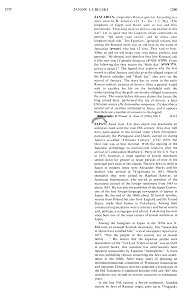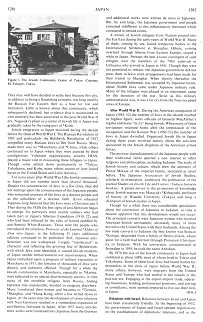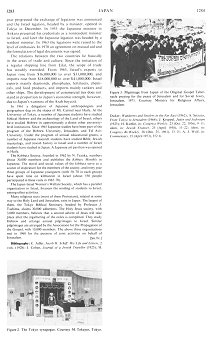Jews in Japan
Jewish merchants since 1861 - immigration of Russian Jews since 1881 - anti-Semitism since 1922 from Russian expedition - Manchuria since 1931 - religious wave in Japan after the defeat since 1945
from: Japan; In: Encyclopaedia Judaica 1971, vol. 9
presented by Michael Palomino (2007)
| Share: |
Facebook |
|
Twitter
|
|
|
|
<JAPAN, Asian state.
For Jews Japan was practically an unknown land until the mid-19th century. Jews may well have participated in the limited trade which Europeans, particularly the Portuguese and Dutch, carried on during Japan's so-called "Christian Century" (1542-1639), but their role was at best minimal.
With the opening of the Japanese archipelago to international relations after the arrival of Commodore Matthew C. Perry of the U.S. Navy in 1853, however, a small number of Jewish merchants settled down for greater or lesser periods of time in the principal port cities of the islands.
[since 1861: Jewish merchants in Yokohama]
The first Jews to settle in Japan in modern times were Alexander Marks and his brother who arrived in *Yokohama in 1861. Shortly thereafter they were joined by Raphael Schoyer, an American businessman, who served as president of the municipal council of the foreign settlement from 1865 to about 1867. He was also the publisher of the Japan Express, one of the first foreign-language newspapers to appear in Japan. By the end of the 1860s about 50 Jewish families, mainly from Poland but also from england and the United States, made their homes in Yokohama. Among their communal organizations were a cemetery and burial society and, perhaps, a synagogue and school. Yokohama has ever since been one of the main centers of Jewish settlement in Japan.
[1875: Scottish missionary McLeod states, all Japanese are of Jewish descent]
Among the foreigners in Japan in the 1870s was N. McLeod, an unusual Scottish missionary. His "researches in Japan have satisfied him", a local newspaper reported in 1875, "that the people of this country are of Jewish family..." His notion that the Japanese people were descendants of the "Ten Lost Tribes of Israel" was set forth in several books; This nonsense has unfortunately been repeated occasionally by Japanese "Judeophiles".
[1882-1887: Old Testament in Japanese published]
A more serious publishing venture concerning the Jews was undertaken in the 1880s. After many years of planning an interdenominational committee of Protestant missionaries and Japanese Christian converts prepared a translation of the Old Testament. Completed between 1882 and 1887, this translation was revised on several occasions in subsequent years.
[since 1881: Russian Jews in Nagasaki]
In the late 19th century a Jewish settlement, founded mainly by Jews of Russian origin, grew up at *Nagasaki. (col. 1280)
The main well have decided to settle here because this city, in addition to being a florishing entrepôt [[free haven]], was long used by the Russian Far Eastern fleet as a base for rest and recreatikon. Little is known about this community, which subsequently declined, but evidence that it maintained its own cemetery has been uncovered in the post-World War II era. Nagasaki's place as a center of Jewish life in Japan was gradually taken by the rising port of *Kobe.
[since 1905 and 1917: Russian Jewish immigration to Japan as a flight from revolutions - transit stay - since 1919: "several thousand"]
Jewish emigration to Japan mounted during the decade before the close of World War I. The Russian Revolution of 1905 and particularly the Bolshevik Revolution of 1917 compelled many Russian Jews to flee from Russia. Many made their way to *Manchuria and *China, while others continued on to Japan where they were assisted by their coreligionists. Volunteer organizations, notably HIAS, played a major role in evacuating these refugees to Japan. Though some settled down permanently in *Tokyo, Yokohama, and Kobe, many others sooner or later found haven in the United States and Latin America. For some years after World War I the Jewish community in Japan did not number more than several thousand.
[since 1923 approx.: Anti-Semitism brought by Japanese soldiers from Siberian expedition]
Despite the concentration of Jews in a few cities, they did not impinge upon the consciousness of the Japanese people, who remained unaware of the Jews as a distinct people and as the upholders of a distinct faith. (Even educated Japanese long believed that the Jews were a Christian sect!) Then during the 1920s the first signs of anti-Semitism began to emerge. Its purveyors were mainly soldiers who had taken part in Japan's Siberian Expedition (1918-22) and who had been infected by the tales of hatred peddled by anti-Semitic White Russians.
these were the people who introduced the infamous Protocols of the Learned *Elders of Zion into Japan; in the following 35 years additional editions continued to be published. Still, Japanese anti-Semitism was not widespread. Largely "intellectual" in character and reflecting the growing fear of Bolshevism, with which Jews were identified, it caused Jewish residents of Japan neither embarrassment nor inconvenience.
[since 1931: Jewish emigration movement from Japanese Manchuria]
When Japan embarked upon a program of military expansion in Manchuria in 1931, the fortunes of thousands of Jews were directly and indirectly affected. Though for a while the Jewish communities in Manchuria, especially in *Harbin, were subjected to no special discriminatory actions, in time many of the erstwhile refugees from Russia, finding Japanese rule unpalatable, decided to emigrate elsewhere. Many transferred their homes and business to *Tientsin, *Shanghai, and *Hong Kong, while a few settled down in Japan.
[since 1938 approx.: link with Nazi Germany - rise of anti-Semitic literature in Japanese - indifferent government and population]
At the same time the development of closer relations with Nazi Germany resulted in a tremendous expansion of anti-Semitic literature in Japan. After 1937 many anti-Semitic works were translated into Japanese from the German (col. 1281)
and additional works were written de novo in Japanese. But, by and large, the Japanese government and people remained indifferent to this inflammatory literature which circulated in limited circles.
[1939-1941: Influx of European Jewish refugees to Japan and China - 1942-1945 - Japanese occupation of Shanghai]
A stream of Jewish refugees from Nazism poured into the Far East during the early years of World War II. Many of them, coming by sea, found temporary homes in the International Settlement at Shanghai. Others, coming overland through Siberia from Eastern Europe, stayed a while in Japan. Perhaps the best known contingent of such refugees were the members of the *Mir yeshivah [[religious Torah school of Mir]] in Lithuania who arrived in Japan in 1941. Though they were not permitted to remain, the Japanese government did not press them to leave until arrangements had been made for their transit to Shanghai.
When shortly thereafter the International Settlement [[in Shanghai]] was occupied by Japanese forces, about 50,000 Jews came under Japanese military rule. Many of the refugees were placed in an internment camp for the duration of the war. Strict as this military administration was, it was a far cry from the Nazi-occupied areas of Europe.
After World War II.
[1945-1952: "US" occupation of Japan - high number of Jews in Japan]
During the American occupation of Japan (1945-52) the number of Jews in the islands reached its highest figure, some officials of General MacArthur's regime and many "G.I.s" being Jewish. When many of these servicemen returned home after the termination of the occupation and the Korean War (1950-53) the number of Jews in Japan dwindled. Organized Jewish life in Japan during these years revolved mainly about the activities sponsored by the Jewish chaplains of the American armed forces.
[Religious wave in Japan after the defeat - Jewish studies in Japan]
The postwar disenchantment of the Japanese people with their traditional faiths spurred a new interest in other religions and philosophies, including Judaism. The study of Jewish history and culture, which drew the attention of Prince Mikasa of the imperial family, increased as never before. The Japanese Association of Jewish Studies, scholarly in orientation, undertook the publication of the journal Studies on Jewish Life and Culture (Yudaya-Isuraeru Kenkyu). A prime mover in the promotion of knowledge about Jewish matters was Masayuki *Kobayashi, professor of history at Waseda University (Tokyo) and long a champion of Jewish studies in Japan.
[since 1952: conversions: Japanese women - emigration movement to the "USA" - some Japanese men]
Though for a while there was considerable speculation about the conversion of Japanese to Judaism, in time it became apparent that this development would not occur. The principal converts were Japanese women who married American-Jewish servicemen; ultimately many of them moved to the United States with their husbands. Among the few male converts to Judaism the best known was Setsuzo *Kotsuji, descended from a family of Shinto priests, whose quest for a faith had led him through Protestant Christianity to Judaism. With his conversion, consummated in Jerusalem in 1959, he took the name Abraham.
[1970: about 1,000 Jews in Japan]
By 1970 the size of the Jewish community in Japan had stabilized at about 1,000, most of whom lived in Tokyo and Yokohama. Some of these local Jews had found homes for themselves in the cities of Japan before World War II; many others, however, were migrants from the United States and Europe who had settled in the islands in the postwar era. Engaging in the export-import trade, operating businesses, holding professional positions, and serving as consultants, most seemed prepared to live out their lives in Japan.
[H.K.]
Relations with Israel.
Relations between Israel and Japan have been consistently friendly. At the beginning of 1952, the governments of Japan and Israel opened negotiations on the establishment of diplomatic relations, and as the (col. 1282)
year progressed the exchange of legations was announced and the Israel legation, headed by a minister, opened in Tokyo in December. In 1955 the Japanese minister in Ankara presented his credentials as a nonresident minister to Israel, and later the Japanese legation was headed by a resident minister. In 1963 the legations were raised to the level of embassies. In 1970 an agreement on mutual aid and the formulation of legal documents was signed.
[Direct shipping line from Eilat to Japan - Japan delivers the ships]
The relations between the two countries lie basically in the areas of trade and culture. Since the initiation of a regular shipping line from Eilat, the scope of trade has steadily extended. From 1965, Israel's exports to Japan rose from $16,000,000 to over $31,000,000, and imports rose from $18,000,000 to over $41,000,000. Israel exports mainly diamonds, phosphates, fertilizers, chemicals, and food products, and imports mainly tankers and other ships. The development of commercial ties does not stand in proportion to Japan's economic strength, however, due to Japan's wariness of the Arab boycott.
In 1961 a delegation of Japanese anthropologists and geographers dug on the slopes of Mt. Carmel near Haifa. At the University of Tokyo, a number of Japanese students have studied biblical Hebrew and the archeology of the Land of Israel; other have studied Hebrew in approximately a dozen other university-level institutions.
[since 1965: student and studies exchange programs between Israel and Japan - Japanese youth in kibbutzim]
Since 1965 Japanese studies have been part of the program of the Hebrew University, Jerusalem, and Tel Aviv University. Under the program of annual educational grants, a number of Japanese research students have studied Bible, Jewish musicology, and Jewish history in Israel and a number of Israel students have studies in Japan. A Japanese art pavilion was opened in Haifa.
The Kibbutz Society, founded in 1962 by N. Tezuka, numbers about 30,000 members and publishes the Kibbutz Monthly in Japanese. The moral and social values of the kibbutz serve as a source of inspiration for the members of the society, and every year three groups of Japanese youngsters (with 50-70 in each group have spent time on kibbutzim in Israel (about 550 people participated in these visits in 1965-70).
[Religious splinter groups in Japan with relations to Israel]
Many religious sects (most of them Protestant), related in some way to the Holy Land and Jerusalem, exist in Japan. The largest of them, the Tokyo Biblical Seminary, headed by Professor J. Tashima, claims 30,000 adherents. The Holy Jesus society, with 3,000 members, believes that a second advent of Jesus will take place after the ingathering of the exiles is completed. They study Hebrew and arrange annual pilgrimages to Israel. Similar pilgrimages are arranged by the Association for the Propagation of the Gospel, with 10,000 members. The above three organizations met in 1968 for the purpose of joint activities on behalf of Jerusalem.
[SH.TU.]> (col. 1283)
<Bibliography
-- C. Adler: Jacob H. Schiff: His Life and Letters, 2 vols. (1928)
-- I. Cohen: Journal of a Jewish Traveller (1925)
-- H. Dicker: Wanderers and Settlers in the Far East (1962)
-- A. Setsuzo: From Tokyo to Jerusalem (1964)
-- J. Kreppel: Juden und Judentum (1925)
-- H. Kublin, in: Congress Weekly, 12 (Oct. 22, 1956), 9-11
-- idem, in: Jewish Frontier, 25 (April 1958), 15-22
-- idem, in: Congress Bi-Weekly, 28 (Dec. 25, 1961), 13-15
-- A.J. Wolf, in: Commentary, 15 (April 1953), 352-6> (col. 1283-1284)
Sources
Encyclopaedia Judaica 1971: Japan, vol. 9, col. 1280
Encyclopaedia Judaica 1971: Japan, vol. 9, col. 1281-1282
Encyclopaedia Judaica 1971: Japan, vol. 9, col. 1283-1284
^





